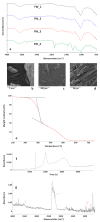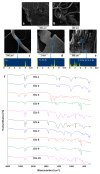Critical Factors for the Recycling of Different End-of-Life Materials: Wood Wastes, Automotive Shredded Residues, and Dismantled Wind Turbine Blades
- PMID: 31581529
- PMCID: PMC6835544
- DOI: 10.3390/polym11101604
Critical Factors for the Recycling of Different End-of-Life Materials: Wood Wastes, Automotive Shredded Residues, and Dismantled Wind Turbine Blades
Abstract
Different classes of wastes, namely wooden wastes, plastic fractions from automotive shredded residues, and glass fiber reinforced composite wastes obtained from dismantled wind turbines blades were analyzed in view of their possible recycling. Wooden wastes included municipal bulky wastes, construction and demolition wastes, and furniture wastes. The applied characterization protocol, based on Fourier transform infrared (FTIR) spectroscopy in attenuated total reflection (ATR) mode, scanning electron microscopy coupled with energy dispersive X-ray spectroscopy (SEM/EDX), and thermogravimetric analysis (TG) coupled with FTIR spectrometry for the investigation of the evolved gases, revealed that the selected classes of wastes are very complex and heterogeneous materials, containing different impurities that can represent serious obstacles toward their reuse/recycling. Critical parameters were analyzed and discussed, and recommendations were reported for a safe and sustainable recycling of these classes of materials.
Keywords: FTIR; characterization; end-of-life vehicles; evolved gas analysis; municipal bulky waste; recycling.
Conflict of interest statement
The authors declare no conflict of interest.
Figures









References
-
- Geissdoerfer M., Savaget P., Bocken N.M.P., Hultink E.J. The Circular Economy – A new sustainability paradigm? J. Cleaner Prod. 2017;143:757–768. doi: 10.1016/j.jclepro.2016.12.048. - DOI
-
- Mei C., Sun X., Wan M., Wu Q., Chun S.J., Lee S. Coextruded Wood Plastic Composites Containing Recycled Wood Fibers Treated with Micronized Copper-Quat: Mechanical, Moisture Absorption, and Chemical Leaching Performance. Waste Biomass Valorization. 2018;9:2237–2244. doi: 10.1007/s12649-017-9992-z. - DOI
-
- Keskisaari A., Kärki T. The use of waste materials in wood-plastic composites and their impact on the profitability of the product. Resour. Conserv. Recycl. 2018;134:257–261. doi: 10.1016/j.resconrec.2018.03.023. - DOI
-
- Hossain U., Poon C.S. Comparative LCA of wood waste management strategies generated from building construction activities. J. Cleaner Prod. 2018;177:387–397. doi: 10.1016/j.jclepro.2017.12.233. - DOI
Grants and funding
LinkOut - more resources
Full Text Sources
Miscellaneous

